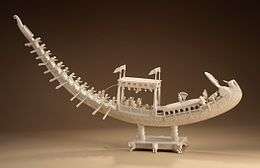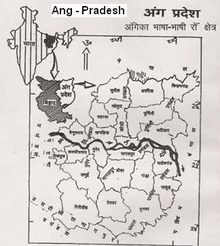Anga
| Anga Kingdom | |||||
| |||||
.png) Anga and other kingdoms of the late Vedic period | |||||
| Capital | Champa (Campā) | ||||
| Religion | Vedic Hinduism Buddhism Jainism | ||||
| Government | Monarchy | ||||
| Historical era | Bronze Age, Iron Age | ||||
| • | Established | unknown (?~1100 BCE) | |||
| • | Disestablished | unknown (?~500 BCE) | |||
Part of a series on the |
|---|
| History of Bengal |
 |
| Ancient geopolitical units |
| Ancient and classical dynasties |
| Medieval and Early Modern periods |
| European colonisation |
| Bangladesh |
| Indian Bengal |
| Related |
Anga (अंग aṅga) was a kingdom that flourished on the eastern Indian subcontinent from c. 12th to 6th century BCE until it was annexed by the kingdom of Magadha in the same century. Counted among the "sixteen great nations" (solas Mahajanapadas) in Buddhist texts like the Anguttara Nikaya, Anga also finds mention in the Jain Vyakhyaprajnapti’s list of ancient janapadas. According to Mahabharata, Karna ruled the Kingdom during the period.
Some refer that the Angas were grouped with people of ‘mixed origin’,[1] generally in the later ages.
Etymology
Mahabharata (I.104.53-54) and Puranic literature attest that the name Anga had originated eponymously from the name of Prince Anga, the founder of the kingdom. According to some scriptures (Mahabharata and some Puranas), a king Bali, the Vairocana and the son of Sutapa, had no sons. So, he requested the sage, Dirghatamas, to bless him with sons. The sage is said to have begotten five sons through his wife, the queen Sudesna.[2] The princes were named Anga, Vanga, Kalinga, Sumha and Pundra.[3][4] The princes later founded kingdoms named after themselves. The prince Vanga founded Vanga kingdom, in the current day region of Bangladesh and part of West Bengal. The prince Kalinga founded the kingdom of Kalinga, in the current day region of coastal Orissa, including the North Sircars.[5]
Ramayana (1.23.14) narrates the origin of name Anga as the place where Kamadeva was burnt to death by Siva and where his body parts (angas) are scattered.[6]
History
The earliest mention occurs in the Atharava Veda (V.22.14) where they find mention along with the Magadhas, Gandharis and the Mujavatas, all apparently as a despised people.
Puranic texts place the janapadas of the Angas, Kalingas, Vangas, Pundras (or Pundra Kingdom - now some part of Eastern Bihar, West Bengal and Bangladesh), Vidarbhas, and Vindhya-vasis in the Purva-Dakshina division.[7]
The Puranas also list several early kings of Anga. The Mahagovinda Suttanta refers to king Dhatarattha of Anga. Jain texts refer to Dhadhivahana, as a ruler of the Angas. Puranas and Harivamsa represent him as the son and immediate successor of Anga, the eponymous founder of the kingdom. Jain traditions place him at the beginning of sixth century BCE.
Between the Vatsas and the realm of Anga, lived the Magadhas, who initially were comparatively a weak people. A great struggle went on between the Angas and its eastern neighbors. The Vidhura Pandita Jataka describes Rajagriha (the Magadhan Capital) as the city of Anga and Mahabharata also refers to a sacrifice performed by the king of Anga at Mount Vishnupada (at Gaya). This indicates that Anga had initially succeeded in annexing the Magadhas, and thus its borders extended to the kingdom of Matsya country.
This success of Angas did not last long. About the middle of 6th century BCE, Bimbisara, the crown prince of Magadha had killed Brahmadatta, the last independent king of Anga and seized Champa. Bimbisara made it as his headquarters and ruled over it as his father's Viceroy. Thenceforth, Anga became an integral part of growing Magadha empire (PHAI, 1996).
Location

Based on Mahabharata evidence, the kingdom of the Angas roughly corresponded to the districts of Begusarai, Bhagalpur, Banka, Purnia, Munger, Katihar and Jamui in Bihar and districts of Deoghar, Godda, and Sahebganj in Jharkhand; later extended to include Malda and Uttar Dinajpur in Bengal. The River Champa (modern Chandan) formed the boundaries between the Magadha in the west and Anga in the east. Anga was bounded by river Koshi on the north. According to the Mahabharata, Duryodhana had named Karna the King of Anga.
Sabhaparava of Mahabharata (II.44.9) mentions Anga and Vanga as forming one country. The Katha-Sarit-Sagara also attests that Vitankapur, a city of Anga was situated on the shores of the sea. Thus the boundaries of Anga may have extended to the sea in the east.
Capital
The capital of Anga was Champa (Campā). According to Mahabharata and Harivamsa, Champa was formerly known as Malini[N.B. 1]. Champa was located on the right bank of river Ganges near its junction with river Champa. It was a very flourishing city and is referred to as one of six principal cities of ancient India (Digha Nikaya). Bhagalpur in Bihar, usually identified as the site of Champa, still has two villages called Champa-nagara and Champa-pura.[10]
Champa was noted for its wealth and commerce. It was also a great center of trade and commerce and its merchants regularly sailed to distant Suvarnabhumi for trading purposes. During his pilgrimage there in the end of the 4th century, the Chinese monk Faxian noted the numerous Buddhist temples that still existed in the city, transliterated Chanpo in Chinese (瞻波 pinyin: Zhānbō; Wade–Giles: Chanpo)[N.B. 2]. The kingdom of Anga by then had long ceased to exist; it had been known as Yāngjiā (鴦伽) in Chinese.[N.B. 3]
List of rulers
- Anga - (eponymous founder of the kingdom and son of King Vali)
- Karna
- Brihadratha
- Vrishasena - Son. 'Chief of the Angas'.
- Samudrasena - Possible king of Vanga?.
- Chandrasena - Possible king of Vanga?.
- Tamralipta
- Lomapada - (a friend of the King of Kosala Dasaratha).
- Chitraratha
- Vrihadratha
- Vasuhoma
- Dhatarattha (noted in the Mahabharata).
- Dhadivahana (also noted in the Mahabharata).
- Bramhadatta - Last king of Anga.
See also
- Kingdoms of Ancient India
- Anga Lipi
- Mahajanapadas
- History of Jharkhand
- Anga Kingdom
- Bhagalpur
- Manjusha Art
- Janapada
Notes
- ↑ Variously written as Mālinī,[9] Mālini, Mālina[10]
- ↑ Campā (Indian, not Vietnamese) was also transliterated, besides 瞻波, in the records as Zhanbopo (瞻博婆) and Zhanpo (瞻婆、瞻匐、瞻蔔、詹波、闡蔔、閻波、占波)[9]
- ↑ Anga was also transliterated, besides 鴦伽, in the records as 鴦迦 (different radical for jiā), 泱伽 (same pronunciation), Yāngjué (鴦掘), Àng'é (盎誐). Sometimes by metonymy, the kingdom would be called the ‘State of Champa’‘’, i.e., 瞻波國.[9]
External links
References
- ↑ Bodhayana Dharma Sutra
- ↑ Devendrakumar Rajaram Patil (1946). Cultural History from the Vāyu Purāna. Motilal Banarsidass Pub. p. 46.
- ↑ J.P. Mitta (2006). History of Ancient India: From 7300 BC to 4250 BC. Atlantic Publishers & Dist.
- ↑ V. R. Ramachandra Dikshitar (1999). War in Ancient India. Genesis Publishing Pvt Ltd. p. 53.
- ↑ Gaṅgā Rām Garg (1992). Encyclopaedia of the Hindu World, Volume 1. Concept Publishing Company. Retrieved 28 October 2012.
- ↑ Balakanda Book I, Chapter 23
- ↑ The Garuda Purana 55.12; V.D. I.9.4; the Markendeya Purana 56.16-18
- ↑ Millard Fuller. "(अंगिका) Language : The Voice of Anga Desh". Angika.
- 1 2 3 佛光電子大辭典 (Buddha's Light Electronic Dictionary). Taiwan: Buddha's Light Publishing (Fo Guang Shan)
- 1 2 G P Malalasekera, Dictionary of Pali Proper Names. 1937.
